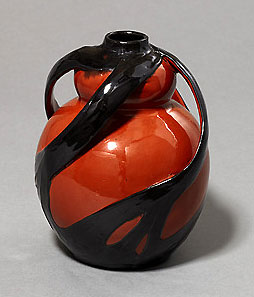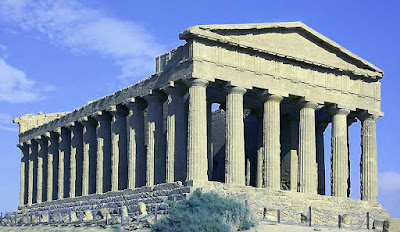The Nature and Evolution of Art and Architecture as Structures of Consciousness

A Series of Educational Lectures on the History of Design
by Mariano Akerman

COMSATS Institute of Information Technology (CIIT)
Johar Campus, H-8/1, Chak Shahzad, Islamabad, Pakistan
March-May 2011

TRADITION AND INNOVATION
The Nature and Evolution of Art and Architecture as Structures of Consciousness
Throughout the ages, design has involved an ordered realm, one consistent with man’s aspirations and circumstances.
In Antiquity, Vitruvius celebrated the concept of re-presentation (mimesis) in art and established as three the main features of architecture. Lao Tsu on the other hand understood the essential as a harmony of opposites.
From Ancient Egypt to 18th-century France, academic canons and norms were developed in order to organize and regulate art and design. The French Revolution celebrated the notion of Freedom and the Industrial Revolution emphasized that of Progress. New technologies offered new solutions, although they not always entirely satisfactory. There was also a temptation to go back, repeating past models: this approach was not totally satisfactory either. A third one led to hybrid fabrications.
Only Modernity brought real innovation. Functionalism was mostly inspired by the machine aesthetic and provided important solutions. However, it eventually became a dogma that supressed the historical past and the very notion of identity in architecture.
After WWII, the Age of Pluralism began, being Post-Modern Architecture built upon the principles of integration and identity. As Louis Kahn once pointed out, "a stripped-painted horse is not a zebra" and "a good question is greater than the most brilliant answer." Thanks to him, today we can speak of Structures of Consciousness.
Along the lectures on "Tradition and Innovation," Mariano Akerman analyzes and interprets the nature, historical context and development of the arts, architecture and design.
LECTURES' SCHEDULE
1. Tradition and Innovation
Main Library. Friday, March 4th, 2011

We shape clay into a jar, but it is the emptiness inside
that holds whatever we want. —Lao Tsu
2. Classicism
Friday, April 8th, 2011

Utilitas, Firmitas, Venustas. —Vitruvius

The column is the principal ornament of the architecture. —Leone B. Alberti
3. The Illustration
Friday, April 29th, 2011

I belong to those who from darkness to light aspire. —Wolfgang von Goethe
4. Functionalism
Friday, May 20th, 2011
Form follows function. —Louis Sullivan
Ornament is a crime. —Adolf Loos

Every architect is—necessarily—a great poet. Hew must be a great original interpreter of his time, his day, his age. —Frank Lloyd Wright

The house is a machine for living in. —Le Corbusier

Less is more. —Mies van der Rohe
5. Pluralism
Wednesday, May 25th, 2011

Less is a bore.
I prefer ‘both-and’ to ‘either-or,’ black and white, and sometimes gray, to black or white. A valid architecture evokes many levels of meaning and combinations of focus; its space and its elements become readable and workable in several levels at once.
—Robert Venturi

I thought of the beauty of ruins...
Of things which nothing lives behind...
And so I thought of wrapping ruins around buildings.
What does this building wants to be?
Monumentality in architecture may be defined as a spiritual quality inherent in a structure which conveys the feeling of its eternity, that it cannot be added to or changed.
The same order created the dwarf and Adonis.
Order is intangible.
Order supports integration.
—Louis Kahn

Order Is
Mariano Akerman, Architect and Historian
Born in Buenos Aires, Mariano Akerman studied at the School of Architecture and Urbanism of Universidad de Belgrano (Argentina), completing his education with a prized graduation project on The Boundaries and Space in Architecture (1987).
Abroad from 1991 onwards, he has researched the paintings of Francis Bacon and the architectural projects of Louis I. Kahn.
In Asia, Mariano Akerman has been developing the series of conferences The Belgian Contribution to the Visual Arts (2005), In the Spirit of Linnaeus (2007), Discovering Belgian Art (2008-9), Raisons d’être, German Art, and Shape & Meaning (2010).
Specializing in visual communication, Akerman is an experienced educator. He gives lectures on modern art and architecture at the Museo Nacional de Bellas Artes in Buenos Aires, the National Museum in Manila, the National College of Arts in Lahore and the National University of Modern Languages and COMSATS IIT in Islamabad.
An artist himself, Mariano Akerman exhibits his paintings since 1979. He has been awarded with twelve major international prizes.
References and credits for the illustrations
Opening image: Richard Nickel, Ornament, photo-collage, 2008
1. Jugendstil Vase, by Max Läuger (1898). Victoria & Albert Museum, London
2. Classical Temple in Agrigento, Sicily; Colosseum, Rome
3. Thomas Cole, The Architect's Dream, 1840. Toledo Museum, Ohio, USA
4. Frank Lloyd Wright, Fallingwater House, Bear Run, Pennsylvania, 1936 ; Le Corbusier, Ville Savoie, Poissy, France, 1928-31 ; Ludwig Mies van der Rohe, Farnsworth House, Plano, Illinois, USA, 1950
5. Charles Moore, Piazza d'Italia, New Orleans, USA, 1975-79 ; Louis I. Kahn, Hurva Synagogue Project, 1967-74, computer graphics by Kent Larson
Online Resources
Visual Communication at COMSATS
Historia de la Arquitectura
Western Architecture Timeline
Great Buildings Collection
Kahn and Hurva
From the Ruins

"So therefore I thought of the beauty of ruins... of things which nothing lives behind... and so I thought of wrapping ruins around buildings; you might say encasing a building in a ruin so that you look through the wall which has its apertures as if by accident... I felt this would be an answer to the glare problem." -Kahn, interview, Perspecta 7, 1961, 9-18.

A Series of Educational Lectures on the History of Design
by Mariano Akerman

COMSATS Institute of Information Technology (CIIT)
Johar Campus, H-8/1, Chak Shahzad, Islamabad, Pakistan
March-May 2011

TRADITION AND INNOVATION
The Nature and Evolution of Art and Architecture as Structures of Consciousness
Throughout the ages, design has involved an ordered realm, one consistent with man’s aspirations and circumstances.
In Antiquity, Vitruvius celebrated the concept of re-presentation (mimesis) in art and established as three the main features of architecture. Lao Tsu on the other hand understood the essential as a harmony of opposites.
From Ancient Egypt to 18th-century France, academic canons and norms were developed in order to organize and regulate art and design. The French Revolution celebrated the notion of Freedom and the Industrial Revolution emphasized that of Progress. New technologies offered new solutions, although they not always entirely satisfactory. There was also a temptation to go back, repeating past models: this approach was not totally satisfactory either. A third one led to hybrid fabrications.
Only Modernity brought real innovation. Functionalism was mostly inspired by the machine aesthetic and provided important solutions. However, it eventually became a dogma that supressed the historical past and the very notion of identity in architecture.
After WWII, the Age of Pluralism began, being Post-Modern Architecture built upon the principles of integration and identity. As Louis Kahn once pointed out, "a stripped-painted horse is not a zebra" and "a good question is greater than the most brilliant answer." Thanks to him, today we can speak of Structures of Consciousness.
Along the lectures on "Tradition and Innovation," Mariano Akerman analyzes and interprets the nature, historical context and development of the arts, architecture and design.
LECTURES' SCHEDULE
1. Tradition and Innovation
Main Library. Friday, March 4th, 2011

We shape clay into a jar, but it is the emptiness inside
that holds whatever we want. —Lao Tsu
2. Classicism
Friday, April 8th, 2011

Utilitas, Firmitas, Venustas. —Vitruvius

The column is the principal ornament of the architecture. —Leone B. Alberti
3. The Illustration
Friday, April 29th, 2011

I belong to those who from darkness to light aspire. —Wolfgang von Goethe
4. Functionalism
Friday, May 20th, 2011
Form follows function. —Louis Sullivan
Ornament is a crime. —Adolf Loos

Every architect is—necessarily—a great poet. Hew must be a great original interpreter of his time, his day, his age. —Frank Lloyd Wright

The house is a machine for living in. —Le Corbusier

Less is more. —Mies van der Rohe
5. Pluralism
Wednesday, May 25th, 2011

Less is a bore.
I prefer ‘both-and’ to ‘either-or,’ black and white, and sometimes gray, to black or white. A valid architecture evokes many levels of meaning and combinations of focus; its space and its elements become readable and workable in several levels at once.
—Robert Venturi

I thought of the beauty of ruins...
Of things which nothing lives behind...
And so I thought of wrapping ruins around buildings.
What does this building wants to be?
Monumentality in architecture may be defined as a spiritual quality inherent in a structure which conveys the feeling of its eternity, that it cannot be added to or changed.
The same order created the dwarf and Adonis.
Order is intangible.
Order supports integration.
—Louis Kahn

Order Is
Mariano Akerman, Architect and Historian
Born in Buenos Aires, Mariano Akerman studied at the School of Architecture and Urbanism of Universidad de Belgrano (Argentina), completing his education with a prized graduation project on The Boundaries and Space in Architecture (1987).
Abroad from 1991 onwards, he has researched the paintings of Francis Bacon and the architectural projects of Louis I. Kahn.
In Asia, Mariano Akerman has been developing the series of conferences The Belgian Contribution to the Visual Arts (2005), In the Spirit of Linnaeus (2007), Discovering Belgian Art (2008-9), Raisons d’être, German Art, and Shape & Meaning (2010).
Specializing in visual communication, Akerman is an experienced educator. He gives lectures on modern art and architecture at the Museo Nacional de Bellas Artes in Buenos Aires, the National Museum in Manila, the National College of Arts in Lahore and the National University of Modern Languages and COMSATS IIT in Islamabad.
An artist himself, Mariano Akerman exhibits his paintings since 1979. He has been awarded with twelve major international prizes.
References and credits for the illustrations
Opening image: Richard Nickel, Ornament, photo-collage, 2008
1. Jugendstil Vase, by Max Läuger (1898). Victoria & Albert Museum, London
2. Classical Temple in Agrigento, Sicily; Colosseum, Rome
3. Thomas Cole, The Architect's Dream, 1840. Toledo Museum, Ohio, USA
4. Frank Lloyd Wright, Fallingwater House, Bear Run, Pennsylvania, 1936 ; Le Corbusier, Ville Savoie, Poissy, France, 1928-31 ; Ludwig Mies van der Rohe, Farnsworth House, Plano, Illinois, USA, 1950
5. Charles Moore, Piazza d'Italia, New Orleans, USA, 1975-79 ; Louis I. Kahn, Hurva Synagogue Project, 1967-74, computer graphics by Kent Larson
Online Resources
Visual Communication at COMSATS
Historia de la Arquitectura
Western Architecture Timeline
Great Buildings Collection
Kahn and Hurva
From the Ruins

"So therefore I thought of the beauty of ruins... of things which nothing lives behind... and so I thought of wrapping ruins around buildings; you might say encasing a building in a ruin so that you look through the wall which has its apertures as if by accident... I felt this would be an answer to the glare problem." -Kahn, interview, Perspecta 7, 1961, 9-18.
Mariano Akerman at COMSATS
Visual Communication at COMSATS
Power in the Picture






